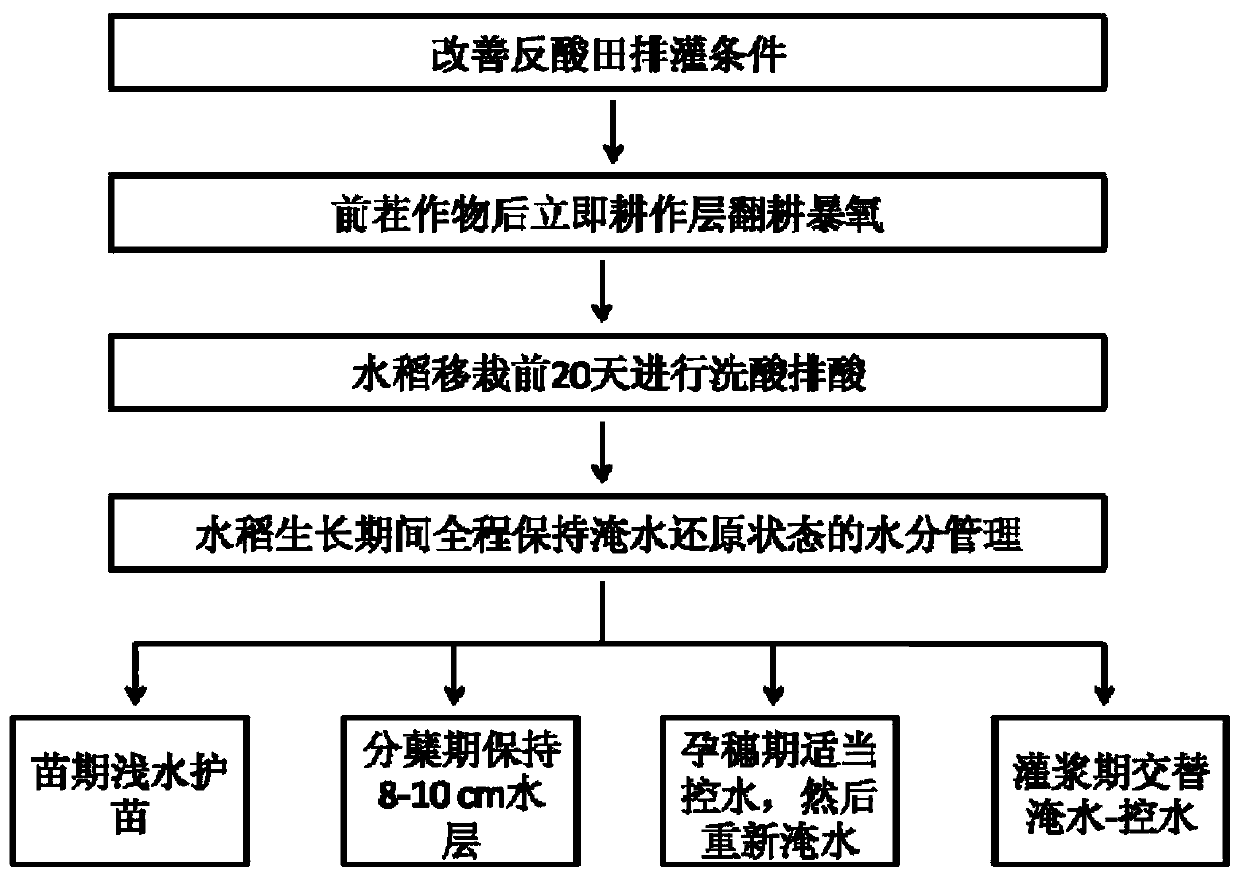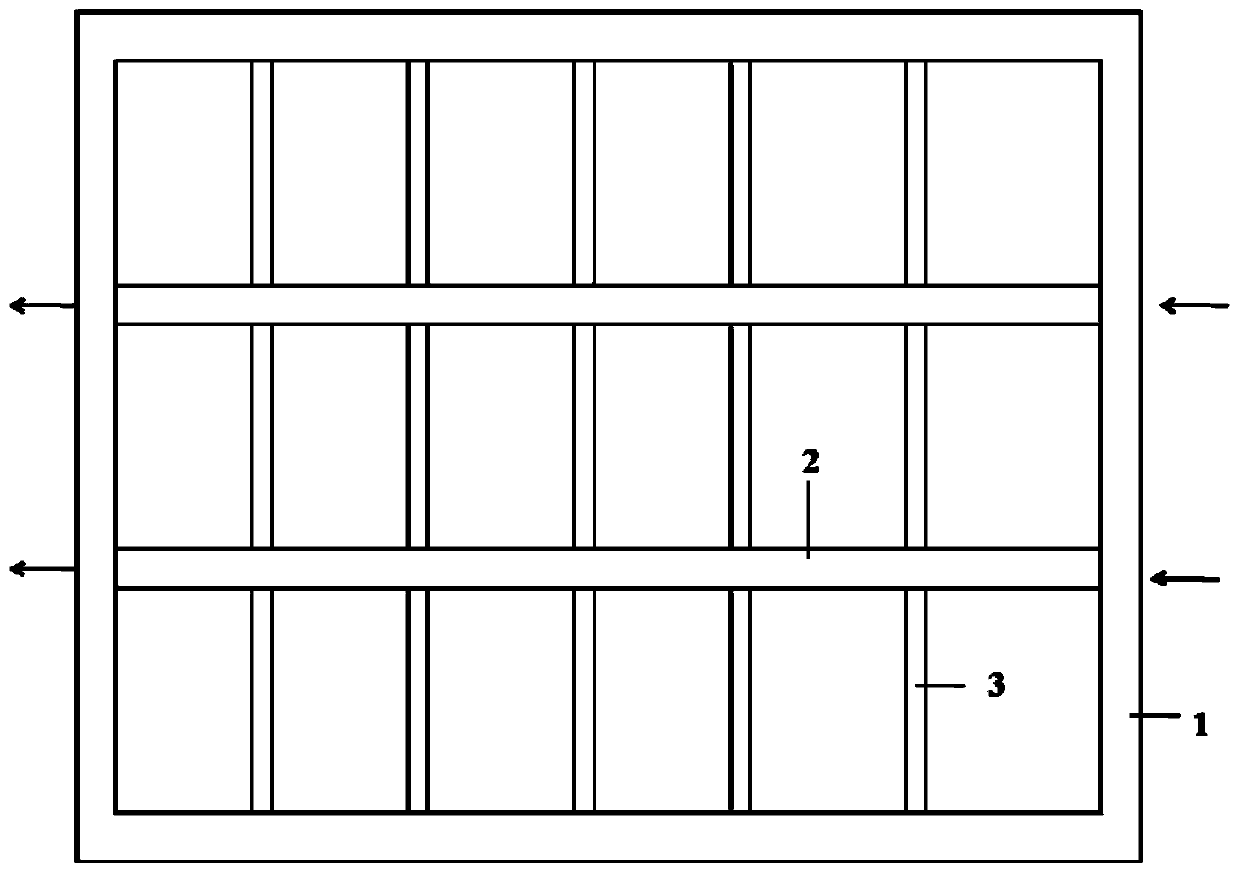Water management method to reduce acid damage in sour-reflected field
A management method and water technology, applied in the fields of soil preparation, agriculture, application, etc., can solve problems such as poor sustainability of improvement effects, secondary obstacles to soil compaction, and difficulty in obtaining effects, so as to prevent acid reflux and inhibit acid reflux. The effect of moving water up and reducing the activity of poisonous metals
- Summary
- Abstract
- Description
- Claims
- Application Information
AI Technical Summary
Problems solved by technology
Method used
Image
Examples
Embodiment 1
[0098] A water management method for alleviating acid damage in acid-reflected fields, the process of which is as follows figure 1 shown, including:
[0099] (a) Drainage and irrigation system design: such as figure 2 As shown, the drainage ditch 1 is dug deep around the acid-reverse field, and the depth of the drainage ditch 1 is 100 cm, and the width of the ditch is 50 cm; The interval is 50m, the ditch depth is 70cm, and the ditch width is 40cm. The interval between auxiliary drainage and irrigation ditches 3 is 30m, the ditch depth is 50cm, and the ditch width is 20cm;
[0100] (b) Plowing oxygen treatment: plowing immediately after the harvest of the previous paddy rice, the plowing depth is 12cm;
[0101] (c) Acid washing and deacidification: Irrigate rice 20 days before transplanting, with a water depth of 5 cm. After soaking for 2 days, drain the water. The drainage should be thorough each time. Repeat this 3 times. Water immediately after the last drainage. 5cm, t...
Embodiment 2
[0108] A water management method for alleviating acid damage in acid-reflected fields, specifically comprising:
[0109] (a) Drainage and irrigation system design: such as figure 2 As shown, the drainage ditch 1 is dug deep around the acid-reverse field, and the depth of the drainage ditch 1 is 100 cm, and the width of the ditch is 50 cm; The interval is 70m, the ditch depth is 70cm, and the ditch width is 40cm;
[0110] (b) Plowing oxygen treatment: plowing immediately after the harvest of the previous paddy rice, the plowing depth is 18cm;
[0111] (c) Acid washing and deacidification: Irrigate rice 22 days before transplanting, with a water depth of 10 cm. After soaking for 3 days, drain the water. The drainage should be thorough each time. Repeat this 3 times. Water immediately after the last drainage. 8cm, to establish a flooded restoration environment;
[0112] (d) Water management during the rice growth period: maintain the flooding and restoration state of the acid...
Embodiment 3
[0118] A water management method for alleviating acid damage in acid-reflected fields, specifically comprising:
[0119] (a) Drainage and irrigation system design: such as figure 2 As shown, the drainage ditch 1 is dug deep around the acid-reverse field, and the depth of the drainage ditch 1 is 100 cm, and the width of the ditch is 50 cm; The interval is 60m, the ditch depth is 70cm, and the ditch width is 40cm. The interval between auxiliary drainage and irrigation ditches 3 is 25m, the ditch depth is 50cm, and the ditch width is 20cm;
[0120] (b) Plowing oxygen treatment: plowing is carried out immediately after the harvest of the previous paddy rice, and the plowing depth is 15cm;
[0121] (c) Acid washing and deacidification: Irrigate rice 18 days before transplanting, with a water depth of 8 cm. After soaking for 2 days, drain the water. The drainage should be thorough each time. Repeat this for 3 times. Water immediately after the last drainage. 6cm, to establish a f...
PUM
 Login to View More
Login to View More Abstract
Description
Claims
Application Information
 Login to View More
Login to View More - R&D
- Intellectual Property
- Life Sciences
- Materials
- Tech Scout
- Unparalleled Data Quality
- Higher Quality Content
- 60% Fewer Hallucinations
Browse by: Latest US Patents, China's latest patents, Technical Efficacy Thesaurus, Application Domain, Technology Topic, Popular Technical Reports.
© 2025 PatSnap. All rights reserved.Legal|Privacy policy|Modern Slavery Act Transparency Statement|Sitemap|About US| Contact US: help@patsnap.com



